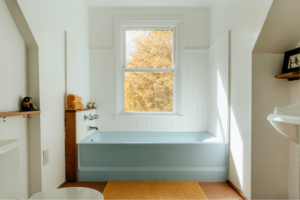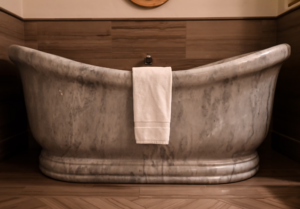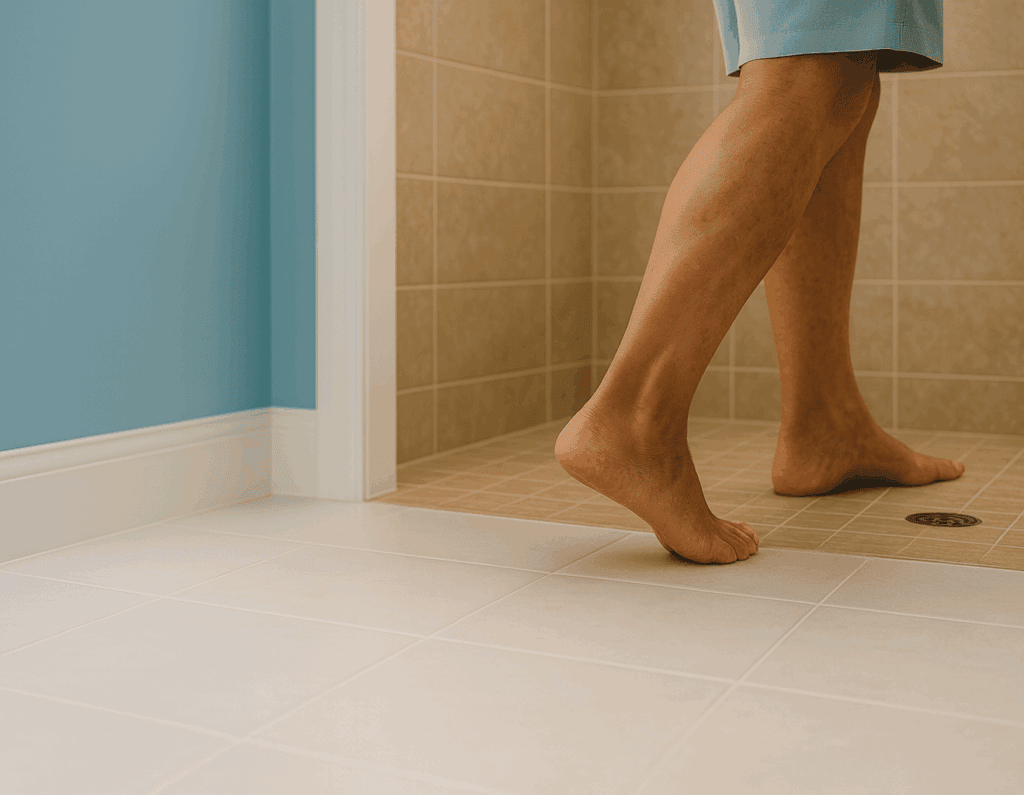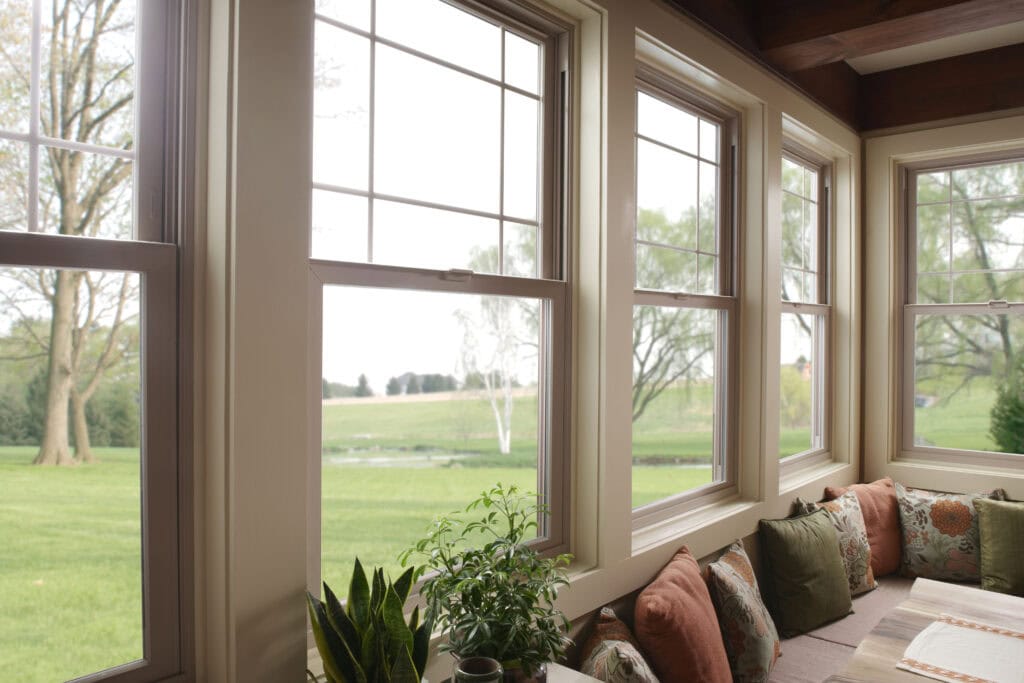The right bathtub can change your entire bathing routine. While some homeowners may focus on size, shape, and advanced features, the material should serve as a foundation since it will impact your tub performance day after day.
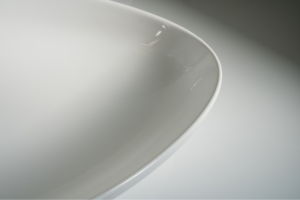
Mad City has extensive hands-on experience with various bathtub materials, and we’re here to help you understand the pros and cons of each one. Let’s discover what we’ve learned from real installations so you can make a choice you’ll be happy with for years to come.
Types of Bathtub Material
Each material comes with its own strengths and limitations that can affect your comfort, maintenance routine, and long-term satisfaction. Let’s explore them in detail so you can see how their features line up with your preferences and pick the one that works best for you.
Fiberglass
Fiberglass is one of the lightest and cheapest tub materials. Manufacturers create these tubs by layering reinforced plastic and applying a special coating on the surface This results in a budget-friendly, practical tub that still looks attractive and can complement different bathroom interiors.
Here are the main benefits of fiberglass tubs:
✅ The cheapest initial cost of any bathtub materials available.
✅ Simple to carry and set up during the installation.
✅ Easy to fix with DIY kits.
But there are also a few downsides to a fiberglass tub to keep in mind:
❌ Shortest lifespan (10-15 years).
❌ Most likely to fade and change color.
❌ Poor heat retention.
Acrylic
A lot of bathrooms have acrylic tubs, and it’s easy to see why. This material goes through a special heating and molding process that gives it nice curves and smooth designs.
Check out what makes acrylic an excellent choice for bathrooms:
✅ Excellent insulation capabilities — retains bath water warmth for 40 to 60 minutes.
✅ Can be easily repaired if it gets scratched or damaged.
✅ Offers the greatest versatility regarding shape and design options.
But before selecting acrylic tubs, think about some of the possible downsides:
❌ Might turn yellow with too much sun exposure.
❌ The surface can get tiny scratches from using abrasive cleaners.
❌ Costs more than some similar fiberglass options.
Ceramic
Ceramic tubs combine aesthetics with strength. Manufacturers subject this material to extremely high temperatures to achieve exceptionally hard and dense surfaces. Pay attention to ceramic if both appearance and durability are your priorities.
Here’s what makes ceramic unique:
✅ Offers outstanding durability suitable for everyday usage.
✅ Most resistant to hard water stains and mineral buildup.
✅ Great surface if you want to add detailed patterns.
However, consider these important factors:
❌ Most prone to cracking from movement.
❌ Needs special skills to get installed right.
❌ Hardest to fix if it gets damaged.
Cast Polymer
Cast polymer provides the appearance of stone without the stone’s disadvantages. It’s a mix of natural minerals with unique resins. Thanks to this combination, cast polymer tubs have luxurious, high-end designs while delivering more practical benefits than natural stone.
The benefits of cast polymer are:
✅ Feels warmer to the touch compared to natural stone.
✅ Offers good value for its luxurious appearance.
✅ Allows for invisible seams in complex installations.
The downsides are the following:
❌ Can get spider cracks over time.
❌ Needs specific cleaning products that can be pricey.
❌ Surface dulls faster than other materials.
Natural Stone
Engineered natural stone adds a touch of raw luxury and one-of-a-kind flair to bathrooms since no two stone tubs are the same. These tubs are made from single chunks of marble, granite, onyx, or travertine. They represent the peak of luxury in bathrooms and often become the focal point of the space.
The pros of stone bathtubs are:
✅ Every tub features its own unique patterns and veining.
✅ With the right care, it can last for centuries.
✅ Non toxic bathtub material.
Yet, pay attention to these limitations:
❌ Due to its heavy weight, you might need special floor reinforcements.
❌ Natural stone is porous and requires careful upkeep.
❌ It’s particularly sensitive to acidic products and harsh cleaners.
Enameled Cast Iron
Enameled cast iron is the most durable bathtub material. Manufacturers cover sturdy iron with a shiny, glass-like coating using high temperatures. Tubs made from this material can last for many generations and still look gorgeous.
The advantages of enameled cast iron tubs include:
✅ The longest lifespan, exceeding 50 years.
✅ Once warm, a cast iron bathtub offers excellent heat retention.
✅ Remains highly stable during use; no flexing.
As with each material, an enameled cast iron tub has its pitfalls:
❌ Very heavy, which often necessitates reinforcing the floor.
❌ High initial costs and installation expenses.
❌ Once installed, it can’t be relocated easily without significant construction work.
Comparison of Materials with Each Other
To help you see the bigger picture, we’ve created a comprehensive bathtub material comparison table that breaks down how each one performs on key factors:
|
Material |
Average Lifespan |
Durability |
Maintenance Level |
Heat Retention |
Weight |
Average Cost* |
|
Fiberglass |
10-15 years |
Low |
High |
Poor |
Very light |
$200-800 |
|
Acrylic |
15-25 years |
Medium |
Moderate |
Excellent |
Light |
$500- |
|
Ceramic |
20-30 years |
High |
Low |
Good |
Heavy |
$1,000- |
|
Cast polymer |
15-20 years |
Medium-high |
Moderate-high |
Good |
Medium |
$1,500- 3,000 |
|
Natural stone |
50+ years |
Very high |
High |
Excellent |
Very heavy |
$5,000- 15,000 |
|
Enameled cast iron |
50+ years |
Very high |
Low |
Excellent |
Very heavy |
$2,000- 4,000 |
*Average cost ranges are for standard-sized tubs without installation.
How to Make the Right Choice
When selecting a bathtub material, determine first how you plan to use your bathroom. Maybe you enjoy taking long baths or rather prefer quick showers. Also, think about those who will be using the tub — if you have kids, you need something more durable and practical, but if it’s just adults, comfort and style might be your thing.
Besides these aspects, pay attention to the following:
- Are There Any Particularities in Choosing a Material Depending on the Bathroom Installation?
The success of your bathtub largely depends on where and how it’s installed. Your bathroom’s location sets clear limits on what materials work best. If it’s on an upper floor, you might want to go with lighter bathtub materials unless you have added support for the floor. On the ground floor, you can choose any material you want, even the heavier ones like cast iron or stone tubs.
2.Which Material Is the Most Durable?
Time tests every bathtub material differently. Natural stone and enameled cast iron are the clear winners since they often serve families for more than 50 years. Sure, they come with a higher price tag upfront, but their lasting power makes them a wise choice.
Other materials, like ceramic and cast polymer, strike a balance between durability and cost-effectiveness. And if you’re on a budget, consider fiberglass and acrylic tubs, although you might have to replace them sooner.
3.Impact of Cost and Brand
Big-name brands usually charge more, but they back up your purchase with decent warranties and trustworthy quality. Smaller brands can offer similar materials at lower prices, but their warranty coverage might not be as good.
Summary: Steps for Choosing the Right Material for the Bathroom
A bathtub purchase shouldn’t be overwhelming, despite the variety of materials and their qualities. Here’s a clear path to help you make the right decision:
- First things first, your bathroom floor is a decisive factor. You need to verify if it can handle the weight of the material you want to use, especially if you have a second-floor bathroom.
- Be honest with yourself about how much time you’re ready to spend taking care of your bathtub.
- Set your budget smartly and include the costs for bathtub replacement and any future maintenance expenses.
- Check out the warranties. Different types of bathtub material and brands come with different levels of protection.
- Keep resale value in mind. Certain materials, like natural stone or cast iron, can boost your home’s appeal to future buyers.
- Finally, make sure to match your style. Sure, durability is essential, but you’ll want to enjoy the style of your tub every time you walk into the bathroom.
Choose your bathtub material with confidence by working with professionals! Mad City is the #1 Bathroom Remodeler in the Midwest. Our bathroom remodeling team has helped thousands of homeowners find and install their perfect bathtub match.
Contact us, and our design experts will share with you every material’s secrets!
FAQ
What is the best material for a bathtub?
There isn’t just one best bathtub material for all homeowners; it depends on what you need. That said, acrylic is often seen as a great all-around pick. It’s tough, keeps the water warm, and comes at a pretty good price. If money isn’t an issue, go for a stone or an enameled cast iron tub.
What is the best material for a freestanding bathtub?
Natural stone and enameled cast iron are the best options for freestanding tubs. They’re stable, maintain water temperature, and look classy. If you’re after more lightweight bathtub materials, a budget-friendly acrylic bathtub is a popular choice, too.
What is the most durable material for a bathtub?
Natural stone and enameled cast iron are the best materials when it comes to durability. They better resist scratches, impacts, and everyday wear and tear than any other options available.
How do I know what material my bathtub is made of?
Give the tub a tap.
- Acrylic or fiberglass tubs will sound hollow and feel warmer since they’re plastic.
- Metal tubs (like cast iron) will sound solid and feel cold.
- Stone tubs will also feel cold, plus they have natural patterns.
You can also check under the rim or behind the access panel for manufacturer labels.
How do I choose a bathtub material?
Consider four main things: your budget, the strength of your bathroom floor, how much proper maintenance you’re willing to do, and how you plan to use the tub. For example, if you want low maintenance and something that will last, choose a cast iron tub. But if you need something more affordable and lightweight, we’ll gladly install an acrylic bathtub for you!

